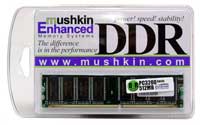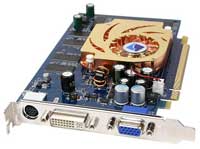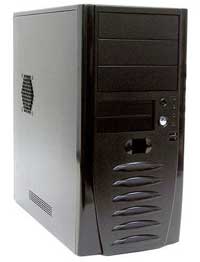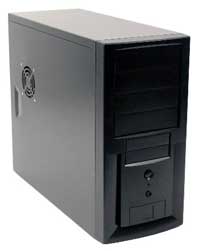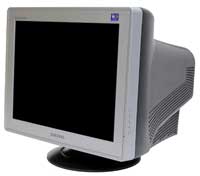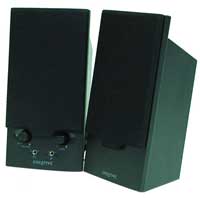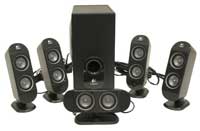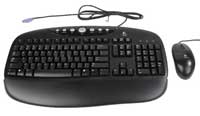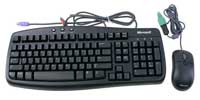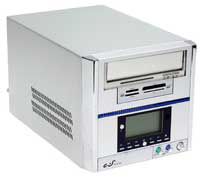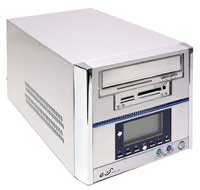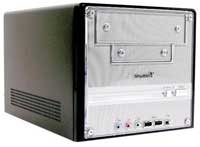
Original Link: https://www.anandtech.com/show/1584
Buyer's Guide - Entry Level, January 2005
by Jarred Walton on January 9, 2005 12:05 AM EST- Posted in
- Guides
Introduction
Budget computing is about two things: reliability and cost. Most people looking for a budget computer don't have a lot of money, and the last thing that they want is to have to go out and replace parts (or buy additional parts) because of some issue that comes up. Performance would be nice to have as well, of course, but that's a distant concern. We've looked at gaming and office configurations in the past, and while much of what has been said still applies, new technologies are always appearing. They may provide a better option in the long run than some of our previous recommendations.One of the biggest concerns that we have right now with the budget sector is the platform. AMD currently has socket A parts and Intel has socket 478 parts, and these are often cheaper than the more recent platforms, but longevity is something of a concern. If you think that you'll want to upgrade some of the parts in the future - especially if you plan on getting a faster processor after a while - we would strongly suggest that you avoid the older platforms. AMD plans to discontinue production of socket A parts in the next couple of months and Intel has similar plans for socket 478. They are still decent platforms in terms of performance, though, so we will not totally discount them as a budget option.
Since we've covered budget gaming several times recently, it will not be a concern in this Guide. Adding in a decent graphics card is the major difference between gaming and non-gaming setups, but there are other considerations as well. What we're going to be looking at are some good picks for a reliable system that won't cost a lot of money. We'll shoot for a price of around $500 as the "base model", but we'll also include some reasonable upgrade selections for those who want a bit more power.
CPU and Motherboard: AMD
We have two options with AMD: socket A or socket 754. Socket 754 costs more, of course, but it generally has better performance and it will have some future processor updates. If you can spare the cash, we recommend going with socket 754. Those who want to save as much money as possible while still getting a decent system will be better served by socket A. This is particularly true if you want to look at motherboards with integrated graphics, as there really aren't many socket 754 boards that include graphics and the quality of the included graphics is almost universally poor. For the cost conscious, then, we'll go with socket A and integrated graphics, and we'll stick with socket 754 as a performance alternative. Socket 939 is yet another alternative, but we feel that the price is just too high now to reasonably fit into a budget system.  |
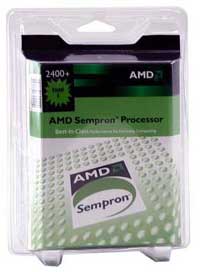 |
| Click images to enlarge. | |
Socket A Motherboard: MSI K7N2GM2-LSR Nforce2 IGP
Price: $72 shipped
Socket A CPU: AMD Sempron 2400+ 256K 1.67 GHz 333 MHz bus
Price: $63 shipped (Retail)
Total: $135
In terms of cost, the Nforce2 IGP motherboards have quite a bit to offer. You get graphics that are roughly the equivalent of a $30 add-in card along with reasonable performance. Reliability of the MSI boards has been very good in our experience, and we also get a few extras. For example, we get SATA hard drive support, courtesy of the more recent MCP-S NVIDIA chip, and all Nforce2 IGP chips have dual-channel RAM support. Unfortunately, we also lose some features like the third DIMM socket and several PCI slots - this is a micro-ATX board instead of a full-size ATX. None of these losses are really that bad, however, and the board as a whole strikes a good balance between cost, features, and performance. MSI also includes their pseudo-rounded IDE and floppy cables, and although they're not as nice as a true rounded cable, they're better than flat IDE/floppy cables in our opinion.
There are several similar boards that make different trade-offs in this price range. For example, we can get a third DIMM socket but lose the SATA support with something like the Chaintech 7NIF2. If we look towards non-IGP solutions, there are even more possibilities, including full-size ATX boards, boards that use a different chipset, firewire support, etc. We don't particularly care for most of the cheaper boards, however, and the more expensive boards get us into the territory of socket 754, making them a rather poor choice where performance is concerned. If you choose a non-IGP Nforce2 motherboard, you should also pay attention to the specific model of the chipset used, as the SPP version does not have dual-channel RAM support.
The processor selection is about the same as it has been for several months on socket A, and we continue to stick with the Sempron 2400+ as the most reasonable choice. Running at 1.67 GHz, it does well in most tasks. We would prefer to get one of the old Barton Athlon XP chips instead, but prices on those have increased and have taken them out of the reach of the budget system. The Athlon XP-M 2500+ can still be had for about $90, and when combined with a moderate heatsink and some overclocking, it can reach decent performance levels, but again, that is moving into the mid-range sector and the domain of the Athlon 64. For overall value, we still like the platform, but performance is nothing special. If you want more performance from an AMD system, we feel that you're better off spending the extra money to shift to socket 754 and the Athlon 64.
 |
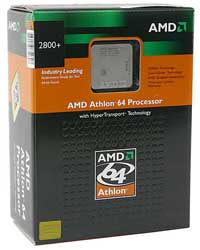 |
| Click images to enlarge. | |
Socket 754 Motherboard: Chaintech VNF-250 Nforce3 250
Price: $73 shipped
Socket 754 CPU: AMD Athlon 64 2800+ 1.8 GHz
Price: $127 shipped (Retail)
Total: $200
Shifting to socket 754, we choose to go with a motherboard that doesn't include integrated graphics. There are boards that use the VIA K8M800 chipset with its S3 UniChrome Pro graphics, and there are also boards that include the SiS Mirage graphics. Performance and reliability of either one are questionable in our opinion. If you don't need decent 3D acceleration, we'd just as soon go out and purchase a cheap Radeon or GeForce card for $30 to $45 and be assured of driver reliability. For the motherboard, then, we end up going with a discrete graphics solution and the tried-and-true Nforce3 250 chipset. There are a few options in the budget sector competing for the lowest price, with the cheapest board coming in at $70 shipped.
At the bottom of the price scale, we're going to stick with the Chaintech VNF-250, due to better memory compatibility. There are some specific memory compatibility issues with the EPoX boards, but they do win out in terms of price and features, depending on the model that you select - the EP-8KDA3I is the base model and costs $70 while the EP-8KDA3J adds Gigabit Ethernet and the hardware firewall of the 250Gb chipset and costs only a few dollars more. The drawback of the EPoX boards is that while they work well with one DIMM, they do not officially support running two double-sided DIMMs in anything more than DDR333 speeds. If you can live with that limitation, the 8KDA3J is still a good board, but we feel that many people will end up running two DIMMs with such a system - perhaps not initially, but adding a second 512 MB DIMM down the road seems very reasonable. Those looking for additional features might want to look at the Biostar K8NHA Grand, as it includes GbE via the 250Gb chipset and adds IEEE1394a firewire support to the mix. We really hate to skimp on the motherboard in any system, as it can have a far-reaching impact on performance and reliability. If it were us buying a computer for ourselves or a friend, we would strongly suggest taking a look at the MSI K8N Neo Platinum for its features and proven track record, but it does cost $100.
For the processor, we looked at the cost of the Sempron parts for socket 754 and decided that they just don't offer enough value. Sure, they're a lot faster than their socket A counterparts, but when they all cost $120 or so and the Athlon 64 2800+ outperforms them and costs only $7 more, why bother? Slower clocked versions of the Sempron for socket 754 are due out in the next month or so, and hopefully, they'll be able to fill in the gap in price from the socket A parts. The questions on the upcoming, slower Semprons are how much cache they will have and how fast they will be clocked (1.6 GHz with 128K of cache is rumored, and without actual benchmarks, it is difficult to say what sort of value such a chip would really offer). For now, we'll stick with the Athlon 64, as the price/performance is still very good and you always have the possibility of increased performance with 64-bit applications in the future. The retail processors also include a better warranty and a certified heatsink, so going with a "cheaper" OEM version rarely ends up as a better deal once you purchase a separate HSF. If you can spend even more money, you could always look at the 3000+ to 3400+ processors. Performance doesn't scale quite as quickly as price, but it's a relatively flat curve at least.
Comparing the socket A CPU/motherboard to the socket 754 parts, we would estimate the socket 754 setup to be about 40% to 50% faster - particularly once you factor in a separate graphics card. It ends up costing 48% more (not counting graphics), so bang-for-the-buck is about equal and you get additional features and more longevity. We would strongly advise anyone looking for a budget computer to save up the extra $100 if at all possible, but the final decision is yours. As we mentioned earlier, socket 939 is also almost in reach of a moderate budget price - it will cost about $50 to $100 more than a similarly powered socket 754 system, and it will offer even more longevity. We continue to place that in the realm of the mid-range system, however, so we'll look more at that platform in an upcoming Guide.
CPU and Motherboard: Intel
The Intel side of things is very similar to the AMD outlook in that we have both socket 478, which is fading out and less expensive while the newer socket 775 takes over. For the mid-range sector and above, we wouldn't consider using the older socket anymore, but for budget systems, there is still plenty to look at. The performance of the integrated graphics on Intel systems is not necessarily great, but it is generally enough for non-gaming use. There are several options for the integrated graphics, even in the budget sector. You have older platforms like the 845G, with which we will not even bother. We also don't care for the S3 and SiS graphics solutions - they work well for some people, but we tend to be a little more finicky.The major choices end up being 865G and 915G from Intel, or the 9100IGP Pro from ATI (note that we do not list the Intel "GV" versions, as we feel that the minor price savings do not make up for their decreased performance). While the performance of the ATI IGP is far superior to the Intel solution, it is still rather slow in comparison to even value graphics cards. Combined with the fact that the overall performance of the 9100IGP is lower than that of the Intel chipset, we find it difficult to recommend the current ATI chipsets. If you need better graphics performance than what the Intel chipsets have to offer, an add-in graphics card would be the far better solution. Price is a different story, however, with most of the Intel chipset motherboards costing more than the alternative chipsets. If pricing is your overriding concern (and you still want to play a few older 3D games), the Gigabyte GA-8TRS350MT or JETWAY A350DMS might be worth a look. (We'd take the Gigabyte as they're a more reputable brand, but the Jetway should work in a pinch. Just remember: Caveat emptor.)
Once you've chosen a socket type and motherboard, you still have the question of which processor to get. Intel's Celeron parts go up against AMD's Sempron, while the Pentium 4 takes on the Athlon 64. In both areas, we feel that the AMD parts have the price/performance advantage, but some people still insist on Intel. If you want the true budget option, we suggest getting a socket 478 system with a Celeron D - remember that the older Celeron only has 128K of cache, and performance is rather abysmal. We'll save socket 775 for the higher performing Pentium 4 processor and forego integrated graphics.
 |
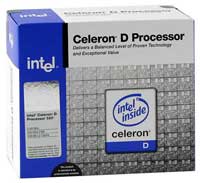 |
| Click images to enlarge. | |
Socket 478 Motherboard: Intel D865GBF i865G
Price: $86 shipped
Socket 478 CPU: Intel Celeron D 320 2.4 GHz 256K L2 Cache
Price: $72 shipped (Retail)
Total: $158
Say what you want about performance, but there's little to question in terms of reliability from an actual Intel-brand motherboard. Overclocking options, voltage adjustment, memory timings...such things are not a concern. What is important is rock solid stability and compatibility. Normally, we would try to find a better alternative, but there really aren't any "enthusiast" quality motherboards with integrated graphics. If you want more performance than what the stock Intel board will offer, we would suggest taking a look at the more expensive alternative.
For the processor, we have gone with the Celeron D 320, a 2.4 GHz part. The next bump up in performance, the 2.53 GHz 325, costs another $12, and beyond that, the prices begin to ramp up quickly. The performance of the Celeron D parts isn't going to set any speed records, but it is acceptable for the price. In contrast to its bigger P4 brothers, the Prescott-based Celeron D manages to outperform the older Northwood-based Celeron parts by a decent margin. The longer pipeline of Prescott only hurts performance slightly relative to the Northwood core, and in the case of the Celeron chips, 128KB of L2 cache is simply not enough for modern applications. So, the 256KB of cache on the Celeron D brings performance up quite a bit.
If you want to look at the newer 915G chipset motherboards - they have even "better" integrated graphics, but we use such a term loosely - they add another $20 to $30 to the price. Our pick for such a board would be the Aopen i915Ga-E at $112. There are a few cheaper boards, but the Aopen board adds some nice features, including GbE and Azalia HD Audio. You would also need a faster Celeron D processor for that platform, as the slowest socket 775 part is the 325J. With the total cost increase coming in at almost $50, we don't see socket 775 as a viable "true" budget platform yet, so we're saving it for the more performance-oriented configuration.
In a direct comparison with the socket A AMD setup, it is a very close match in pricing and performance. Certain tasks will run a bit faster on the Sempron 2400+, and other tasks will run better on the Celeron D 320. Just remember that as configured here, neither system is going to work all that well in gaming or other complex tasks. They are designed to fit the needs of basic computing and maybe a little more. Corners are always cut in an attempt to achieve a budget price, and we aren't immune to those affects. We recommend that most first-time PC buyers spend a little extra rather than scrimping and saving, as needs and wants change over time. These budget systems provide a good base for a computer, however, and upgrading some of the components at a later date shouldn't be too difficult.
For those wondering, the benefit relative to an OEM system like Dell, Gateway, etc. is that you have completely standard parts as well as the ability to add in a graphics card should the need arise in the future. To be honest, at the rock-bottom price point of $500, pre-built OEM systems offer a lot of value as long as you don't want to upgrade anything. If you want to go with a pre-built system, make sure that it has an AGP or PCI Express X16 slot so that you can add a decent graphics card. We encounter quite a few people who purchase OEM computers for a bargain price and aren't worried about gaming performance. Unfortunately, when their children get a bit older or they just change their mind, they often find that there is no way to actually improve the graphics performance to acceptable levels without buying a new motherboard, and that, in turn, leads to buying a new case and power supply. The best PCI graphics cards are currently the Radeon 9200 and GeForce FX 5200, neither of which is particularly useful in modern 3D applications. Even if you don't want a better graphics card, someone in the future probably will.
 |
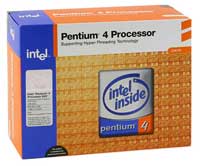 |
| Click images to enlarge. | |
Socket 775/T Motherboard: Chaintech V915P i915P
Price: $96 shipped
Socket 775/T CPU: Intel Pentium 4 520 2.8 GHz 1024K L2 Cache
Price: $158 shipped (Retail)
Total: $254
Socket 775 adds quite a bit to the cost, and relative to the Athlon 64 platform, it's rather difficult to recommend. In all honesty, we view this as more of a mid-range system and would rather see it paired with a decent graphics card and RAM. The Chaintech board includes four DIMM sockets for standard DDR along with a PCIe X16 graphics slot, two PCIe X1 slots, and 3 PCI slots. It also includes Azalia HD audio and Gigabit Ethernet. If you want to save up money in the short term by using integrated graphics, the Aopen board that we mentioned above is still a good option.
For the processor, we select the cheapest socket 775 Pentium 4 that doesn't cut out any features. There are 533 FSB Pentium 4 chips that have HyperThreading disabled, but since they only end up saving $15 to $25, we would rather get the real McCoy. The 2.8 GHz Pentium 4 actually compares better against the Athlon 64 2800+ than most of the other P4 to A64 match-ups. The reason for this is that at 1.8 GHz, the P4 2.8 has a 56% clock speed advantage. The 3.0 compared to the 2.0 GHz 3000+ only enjoys a 50% advantage, and the 2.2 GHz 3200+ compared to the 3.2 only gives Intel a 45% clock speed advantage. Basically, at the bottom end, the 200 MHz drop on the Pentium 4 hurts less than the 200 MHz drop on the Athlon 64. Of course, at a price of $158, you could pick up a faster Athlon 64 chip, so the "advantage" is not really that great. Still, if you want an Intel P4 system, the price/performance ratio of the 2.8 GHz is about as good as it gets.
This platform is really hard to cram into the budget sector, given the feature set. PCI Express is great for the mid-range, with the 6600GT graphics cards representing what is probably the best overall graphics card value. The problem is that a $185 graphics card doesn't fit with a budget system and unfortunately, even the cheapest PCIe graphics cards are still much more expensive than their AGP counterparts. You'll see in the final tally that this ends up being the highest performing of our four system configurations, but it doesn't really qualify for the budget sector. If you're interested in such a system, you're either misunderstanding your needs or you should probably wait for our next Mid-Range Guide before buying. (We'll hopefully get that done within the next week or so.)
Memory
Selecting RAM for a budget computer is always difficult. On the one hand, dual-channel memory will help out performance on most of the platforms that we've listed (the exception being the socket 754 system). On the other hand, we hate to recommend 256 MB DIMMs as they are rather on the small side, and two 512 MB DIMMs is too expensive. For the Athlon 64 configuration, a single 512 MB DIMM is an easy choice. The other platforms - particularly the socket A Sempron system - are not so clear cut. If you get two 256 MB DIMMs on socket A and later want to upgrade to 1 GB, you will have to add in a single 512 MB DIMM and end up running in single-channel mode. The Intel platforms both have four DIMM sockets and so, even with 256 MB DIMMs, they can reach 1 GB. For the time being, 512 MB is enough for most tasks, but if you just want a basic system that you can upgrade further in a few months, we would recommend buying a single 512 MB DIMM now and adding a second later rather than starting with two 256 MB modules. Keep that in mind as you look at our memory recommendations because pricing concerns pretty much force us to use 256 MB DIMMs if we want dual-channel support.Something else worth pointing out is that all of the budget systems that we listed before use DDR memory. If you really want a socket 775 Intel configuration, you could also get DDR2 memory support. That might even increase the performance of the integrated graphics, but it will also add quite a bit to the cost. If you're looking at DDR2-533 memory - and there's no point in getting DDR2 any slower than that - the price for non-generic DIMMs is around $60 for 256 MB modules and $110 for 512 MB modules. That's almost twice as much as the value-oriented DDR memory that we're choosing!
RAM Dual-Channel Recommendation: 2x256 MB Corsair Value Select CL3
Price: $68 shipped
For the dual-channel configuration, we have selected Corsair's 256 MB Value Select RAM. The best price that we could find for this RAM was at Newegg, but you can find similarly priced Samsung, Micron, and Infineon RAM at other locations. Corsair is one of the "reliable" RAM manufacturers, and even though the CAS Latency is rated at 3.0, there's a reasonable chance that tweakers could extract more performance from the RAM. The difference in speed between CL3 and CL2.5 RAM is not particularly large, and for a budget system, you would never notice it. Depending on where you live and/or shop, you might be able to find some other brands of memory for a better price. Crucial, Mushkin, GEIL, and Kingston along with the previously mentioned brands are all safe. You could go with other manufacturers like PNY, PDP or Kingmax without too much concern, and even generic RAM will usually work without problems. For peace of mind, however, we prefer to stick with the better known brands. $20 saved is not worth hours of potential headaches in our opinion.
If you really want to cut costs initially, buying one 256 MB DIMM is certainly an option. Windows XP will still run okay with 256 MB of RAM, and adding a second DIMM at a future date is a relatively simple and painless upgrade. Multitasking will begin to take a pretty noticeable performance hit when you drop down to 256 MB of RAM, but if you usually only run one application at a time, it can get the job done. We don't recommend this option to most people, but it's still there should you want it.
RAM Single-Channel Recommendation: 1x512 MB Mushkin CL2.5
Price: $70 shipped
For the single-channel option (socket 754), we recommend getting one larger DIMM instead of two smaller DIMMs. While it ends up costing $2 more, note that we now get CL2.5 latency instead of CL3 RAM. The performance difference really isn't that great, but CL2.5 256 MB modules would have cost another $10 while here, it's basically "free". The same brand recommendations apply, and if you're willing to risk generic memory, you could get it for as little as $45 to $50. Again, we prefer to spend a little more and have some guarantee of reliability.
While it's not really a budget option, you could also get two of these 512 MB DIMMs and run with a full gigabyte of memory. It's definitely more of a luxury than a requirement for typical computing use, but at the same time, you rarely have to worry about running out of memory even in heavy multitasking scenarios. (Graphics artists, of course, can always use more memory, so the previous statement isn't directed at them.) As we mentioned before, starting with a single 512 MB DIMM and adding a second module in a few months is a good plan if money is tight right now, but you know you'll want more than 512 MB of memory down the road.
Video Cards
Since we have selected budget motherboards that include integrated graphics on the socket A and socket 478 platforms, an add-in graphics card is not required for them. If you want to add a graphics card to such a system, that's easy enough to do, but in that case, you're better off getting a motherboard without integrated graphics. An add-in graphics card is pretty much a requirement for running most recent computer games, and other tasks like video capture will also benefit from having a discrete graphics card. In the past, we have heard some requests for a budget system that doesn't bother with a graphics card, and so that's what we have in this Guide. We still prefer getting motherboards without integrated graphics, but most, if not all, of us also tend to play computer games now and then, so we're biased. Having used and supported various systems with integrated graphics in other environments, we feel pretty safe in saying that the majority of budget computer users will do fine with such a setup.As far as the card selection that we present here, we're going to push the boundaries of "budget" a little higher than normal, on the assumption that if you're not going with the integrated graphics recommendation, you probably want a little more from your graphics card. The GeForce 4 MX440 and Radeon 9200SE are still the cheapest "reasonable" graphics cards, but they're only moderately faster than the integrated solutions. You should be able to find one of those models for $40 to $50 if you want to really cut costs, but buying even a budget Athlon 64 or Pentium 4 system and then pairing it with crippled graphics is a questionable decision. We're not looking at truly capable gaming solutions here, but they should be able to run any current game at reduced detail settings without difficulty. If you would like more information on gaming graphics cards in particular, we recommend checking out our recent Gaming Guide.
AGP Graphics Recommendation: Sapphire Radeon 9600 Pro 128MB DDR 128-bit, 400/600 GPU/RAM clock (bulk/OEM)
Price: $105 shipped
For moderate 3D graphics performance, the Radeon 9600 Pro offers the best bang for the buck. We have selected a Sapphire OEM model here, but really most of the cards perform at about the same level, and when you're on a budget, such concerns as noise levels and overclocking potential take a back seat to price. If you can find a 9600 Pro card for less (or about the same price), then you should be safe buying it. Be careful that you get a standard version and not an "Advantage" or other similarly named model, as there are cards with reduced GPU and RAM clock speeds on the market that share the "9600 Pro" name. The normal clocks for the 9600 Pro are 400 MHz for the core and 600 MHz DDR for the RAM. We have seen 400/400 models with the Pro name, but when you consider that the standard 9600 has a 325/400 clock and can be had for about $30 less money, the semi-Pro models are not a good bargain.
Going up in performance from the Pro is the 9600 XT, which is $30 more typically. With a 500 MHz core clock and the same 600 MHz RAM clock, however, we don't feel that it's worth the additional cost. The 9600 Pro should be more than adequate, and if it's not, you're probably better off spending closer to $200 or more rather than settling for the roughly 20% performance increase that the 9600 XT offers. We have chosen to go with a bulk/OEM model, as the additional programs that ship with a 9600 Pro are not usually worth the added cost, but if you feel differently, you can find retail versions starting at $10 to $15 more.
PCIe Graphics Recommendation: Albatron GeForce 6600 128 MB DDR 128-bit, 300/550 GPU/RAM clock (retail)
Price: $122 shipped
When we move to the PCI Express side of the equation, things change a bit. The absolute cheapest PCI Express graphics cards come in at about $70, and they are basically the equivalent of the Radeon 9600 SE. For those who don't know, the SE usually means that the part has a 64-bit memory interface (typically a bad thing where 3D performance is concerned), and despite the difference in numbers, the X300 and X600 are more or less the same chip with the only difference being the clock speeds. (Technically, the X300 uses the RV370 core and a 110 nm process while the X600 uses the RV380 core and a 130 nm process, but in terms of performance and features, we are not aware of any major architectural differences.) The X300SE and X300 correlate to the AGP 9600 SE and 9600 while the X600 Pro and X600 XT correlate to the AGP 9600 Pro and 9600 XT. Hopefully, if any of you were confused on that subject, we've managed to clear things up a bit.
All that talk of ATI parts may have led you to believe that we were selecting an ATI-base card, but that's not actually the case. The X600 Pro costs about $110 and is the PCIe equivalent of the 9600 Pro. That would make the two platforms equal in graphics performance, but there is a better option for PCI Express. When you look at the superior feature set and performance of the NVIDIA 6600 parts, we feel that they are worth the small bump in price. They include 8 pixel pipelines instead of only 4, which more than makes up for their 300 MHz clock speed. (The X600 Pro would basically need to run at 600 MHz to match the 6600 core's 300 MHz.) Add to that the Shader Model 3.0 support and we feel that the $10 price hike is more than worth the cost. The RAM performance is actually slightly lower, but so long as you don't enable antialiasing or run at really high resolutions in games, you should be fine. There are also 6600 cards that have a 64-bit memory bus, and you should definitely avoid these as they only save about $10 and offer half the memory performance of the full 6600 cards.
None of our graphics card recommendations here are what we would actually call "fast", but they offer reasonable performance for just about any task. Remember also that with the next version of Windows (codenamed Longhorn), 3D graphics support will actually be required in order to run it properly. Specifically, the word is that Pixel Shader 2.0 support will be required. That means that neither of the integrated graphics solutions will be able to run properly, but when you consider that Longhorn is probably two years off, we wouldn't lose any sleep over that fact. The two cards that we've listed here should meet the minimum requirements for Windows Longhorn, and by the time it actually ships, you will probably be able to buy much faster cards for less money. Just remember that if you don't get a decent graphics card now, you will have to buy something in a couple of years. This is why we insist that any newly purchased computer system now include an option to upgrade the graphics at the very least, so no matter how tempting an OEM system might look, if it doesn't have an AGP or PCIe slot, we would stay away from it.
Hard Drives
All of the motherboards that we have selected in this Guide include Serial ATA ports, and so we will confine our hard drive recommendations to that area. It's not that SATA is any faster than PATA in terms of real world performance; it's just that the cables are so much easier to work with and we're rather tired of the cumbersome, old IDE interface. The total difference in price is basically meaningless, usually coming in at less than $5. Of course, picking up the same drive with either interface is possible, so if you want an IDE model due to your motherboard/system choice, don't let the lack of SATA hold you back. In fact, overclockers can generally achieve better results with IDE than SATA.The only issue with SATA drives is that depending on how the SATA support is included on the motherboard, a floppy disk with a driver may be required to install Windows XP. For the Intel systems and the socket 754 option, that shouldn't be required, but the socket A platform may require the use of a floppy disk. Actually, since the NVIDIA MCP-S chip provides the SATA support, you're probably okay there as well - we haven't actually verified this, so we cannot say for sure - however, it's definitely something to pay attention to if you're looking at other motherboard options. Regardless of what platform you choose, though, it is our view that for the added $8-$10 that a floppy drive costs, it is still a useful inclusion. Some BIOS updates still require it, and we already mention the potential XP installation problem. You may only use it a few times a year (if that), but for the one or two times where you actually need it, we hate to scramble around trying to find a workaround.
Hard Drive Recommendation: Seagate 80 GB 7200 RPM 8MB SATA
Price: $69 shipped
We've talked about this in most of the past guides, but to recap, the Seagate drives are a great choice. They come with the longest standard warranty (5 years), they use near-silent fluid dynamic bearings, they offer more than sufficient storage, and their price and performance are more than acceptable. You could save up to $5 by going with a Western Digital PATA drive, but those drives have a tendency to develop a high-pitched whine that we would just as soon not deal with. Maxtor, Hitachi, and Samsung also make similar drives, but the Seagate usually wins out in at least one area, at least with the 80GB SATA drives - their IDE models have started to go up in price, it seems.
Hard Drive Alternative: Samsung 160 GB 7200 RPM 8MB SATA (or IDE)
Price: $92 shipped
Seagate still makes a good hard drive if you want something larger than 80 GB, but as the size increases, their price doesn't stay as low as competitors' offerings. Samsung is just as quiet as Seagate, and at about $20 cheaper than the Seagate SATA drive, we prefer their 160 GB offering. (The IDE version is available for the same price if you want to go that route.) When you get right down to it, the 160 GB Samsung makes a very good alternative to the 80 GB drives. It costs about 33% more, but doubles the storage capacity. Granted, many people won't ever use up even an 80 (or 40) GB hard drive, and that's why the 80 GB drive gets our recommendation. However, if you plan to store a lot of music, movies, images, games, etc. on your computer, it's definitely a worthwhile investment.
Those of you who have been around a while may remember the "good old days" where people used to talk about the price (in dollars) per MB of hard drive capacity. $200 for a 40 MB hard drive was once a bargain! Now, we have the 80 GB drives coming in at 86 cents per GB, and the 160 GB drives are only 57 cents per GB. How many more years until we begin to look at the price per TB of storage for a single hard drive? Technology is a wonderful thing.
Optical and Floppy Drives
With the price of DVD recorders having dropped to under $70 even for the top performing 16X models, we don't see much point in recommending anything less than a DVD recorder as our primary optical drive. Sure, you could save up to $40 by going with a CD-RW, but in the long run, we suggest that you bite the bullet and pick up a DVD+RW instead. 8X DVD+R models might shave off up to $10, if you really want to cut costs by small amounts. The difference in burning speed between 8X and 16X drives is still relatively small due to the lack of 16X media, but that is improving slowly.Optical Drive Recommendation: NEC-3500A/3520A 16X DVD+RW
Price: $65 shipped
The winner of the 16X DVD burners in our last roundup, the NEC 3500A, is also one of the cheapest 16X drives on the market. A newer revision, the 3520A, has also shown up, although that appears to be mostly a BIOS update to the 3500A. We would probably spend the extra couple dollars for the latest revision, but depending on where you shop, you may or may not be able to find it easily. In terms of features, the NEC drives offer about as much as it is possible to cram into an optical drive. Dual-layer DVD+R is available at 4X speeds, DVD+R as well as DVD-R support 16X burn speeds - although especially in the case of the latter, finding media that supports that speed is nearly impossible right now - and the +RW can burn at 8X while the - RW can burn at 6X. The only option really missing is DVD-RAM support, and considering how few people actually use that, we don't feel that it's a major omission. Other decent drives exist, but none can really match the overall price and versatility of the NEC 16X models. Remember to match the drive to the color of your case, of course - an attractive black case won't look good with a beige drive and vice versa. You can also find replacement drive bezels on the Internet, so an aluminum bezel to match your case is also an option.
Floppy Drive Recommendation: 3.5" Floppy Drive
Price: $8 shipped
It's not really required, but for BIOS updates and SATA driver installs as well as the occasional quick and dirty transfer of files, the floppy still has some uses. Flash memory sticks are much more convenient for transferring data between computers, but on most computer systems, it is not possible to use a flash drive in place of a floppy drive for BIOS updates or during the Windows Setup program. You don't have to include a floppy drive, but for the small cost associated with it, we would prefer to keep it around "just in case". As with the optical drive, remember to match the floppy to the color of your case.
Case and Power Supply
Choosing a case for the computer can be as simple or complex as you want to make it. For some, finding the cheapest $20 case available is all they're after, while for others, it will need to match the décor of their office/den/living room. You might also want to buy additional lights to spruce up your case, or more likely quieter fans to make your case less obtrusive. Considering that you'll spend a lot more time looking at your case - and hearing it - than at any of the internal components, we would encourage you to spend more rather than less.Budget-minded PC builders are more likely to stick with the cheaper cases, but we do recommend that you pick up a decent quality power supply if you purchase a $20 case. If you're shopping locally, comparing the weights of power supplies often says a lot about their quality - heavier is better. When shopping online, we would recommend a well-known brand like Antec, Enermax, Fotron Source, PC Power and Cooling, Tagan, and ThermalTake. There are other reliable brands as well, so ask around - our forum members are more than willing to offer their advice on any specific brand that you might be considering, and rather than trying to give a comprehensive list of every PSU available, we suggest that you ask there instead. Once you factor in the cost of a reasonable power supply - 350W is the minimum to buy, in our opinion - getting a better case with a quality power supply included is often as cheap as or cheaper than buying a low end case and adding in a power supply. Some sites (for example, DirecTron.com) will even allow you to custom select a power supply on any case that they offer, which is a nice feature, although the total savings may or may not make that the best option.
By the time that you factor in shipping, ordering a case online can become quite an expensive proposition. Shipping rates can easily cost as much as $25 or $30, depending on the site and weight of the case, so visiting a local shop may end up being a better choice. It might also allow you to check out power supplies, which is an added bonus.
Case Recommendation: Antec SLK1650B with 350W PSU
Price: $76 shipped
Once you factor in the cost of shipping and a reasonable power supply, we find it hard to beat the Antec SLK1650B case (also available in beige as the SLK1650). The advantages of the Antec 1650 are that it is well-built, it includes a relatively quiet power supply and 120 mm temperature controlled rear fan, and a CPU air duct that helps considerably with cooling the processor. With shipping adding almost $20 to the cost, however, it does hurt our overall budget. If you're willing to take the risk of a cheaper power supply, you can easily find cases at a local shop for under $50.
Case Alternative: RaidMax Elite ATX-208BP with 380W PSU
Price: $46 shipped
Our alternative budget case this time is the RaidMax Elite 208BP (available in beige as the 208P). You get what you pay for, and the overall quality of such a case is definitely inferior to the Antec 1650. However, particularly in a budget system, such a case and the included power supply should be more than sufficient. Remember that with the base budget system including integrated graphics as well as a slower processor and less RAM than a "high-end" system, the total power draw is likely to be well under 200W, even at load. The case itself is reasonably attractive, and it includes front USB ports and a side-mounted case fan that blows cool air directly at the processor. RaidMax makes a large variety of cases in many colors, and they are also one of the most inexpensive options. They won't win many awards for silence or innovation - particularly if you actually try running with all seven 80mm fan locations occupied - but they do well in meeting budget constraints.
Again, be forewarned that power supply failure in a year or so is a very real possibility, especially if you begin upgrading and adding additional components. Even the cheapest "quality" power supply will cost $30, equaling the cost of the Antec. Should you want to get a different case and buy a power supply (i.e. you like the way a case looks from the outside, even if the included PSU is junk), the list of PSU manufacturers above is a good place to start, and Fortron Source in particular has quite a few reliable models for $30 or so.
Quiet Fan Alternatives
Price: $5 to $20 plus shipping, depending on model
For those interested in a silent system, one of the best ways to achieve this goal is to get fans that make less noise. Panaflo's L1A series with their Hydro-Wave bearings are one such option, but in general, the best way to make a system quieter is to use fewer fans as well as fans that move less air. The movement of air makes a lot of noise, relatively speaking, and that noise usually more than drowns out that of the fan bearings. Typically speaking, 80 mm fans that spin at more than 2000 RPM are going to make a moderate amount of noise, and 120 mm fans should spin even slower than that (e.g. 1200 to 1500 RPM) as they inherently move more air. Another option for reducing fan noise is to get a voltage converter that will run your fans at 7V instead of 12V - it's just a different way of reducing the RPMs, really. Many motherboards can also adjust fan speeds automatically based on system temperatures, which work to varying degrees. We prefer to get fans with 3-pin motherboard connectors as well as all three wires - the third wire is used to monitor fan RPMs, and it is not always available (e.g. on the Panaflo fans). Antec and Enermax again make some good quality fans for a reasonable price, as do Vantec, Zalman, and several others; just check the RPM and CFM ratings and remember that higher values will equate to more noise. As with power supplies, asking around in our forums can give you more specific advice on any particular model.
Displays
For our displays, we continue to stick with CRTs due to pricing concerns - LCDs simply do not qualify as a budget part. The number of actual tube manufacturers is very small these days, as most display companies have moved on to the more profitable LCD sector, so differences between models are not all that great. What we really want out of a display is a decent refresh rate, a crisp picture, and above all, a flat surface. Convex monitors have been undesirable for over a decade, and we're more than willing to spend a bit more money in order to get a truly flat screen. This means that we're going with aperture grille displays, which some people do not like because of the two thin lines that are visible. We hardly notice the lines and will favor the flatter screens and brighter colors, but some people prefer invar shadow mask CRTs. 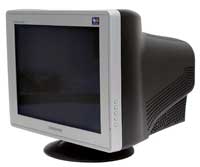 |
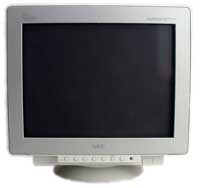 |
| Click images to enlarge. | |
Display Recommendation: Samsung 793DF/793MB or NEC FE771SB 17" CRT
Price: $145 or $160 shipped
The best all-around option for a quality CRT is really a tie right now between the Samsung and the NEC offerings. NEC models tend to cost a bit more, but we're talking about a price difference of less than 10%. You can also find these displays at several of the larger computer stores, i.e. Best Buy and CompUSA, and when combined with special price discounts, you may be able to get them for substantially less money than we've listed here. As far as features go, both the Samsung and NEC displays are nearly identical. The NEC offers a feature called "Super Bright", which will bump up the brightness levels dramatically. It's almost painful to look at text with the SB mode turned on, but when watching movies or playing games, it actually works quite well. Samsung offers a similar feature with their "Magic Bright" technology - this is only available on the "MB" model and not on the "DF" model, however. As for the overall look, Samsung goes with a two-tone and NEC sticks with a solid color. Samsung also places the controls on the side of the monitor while NEC places them on the bottom. The two-tone color effect is one that you will probably either love or hate; personally, we think it looks pretty good and matches up with black or beige cases relatively well. As for the controls, we find the NEC positioning and menus to be more useful, but maybe we're just more used to that setup. Either one will get the job done quite well. Of course, it may be easier to find one or the other depending on where you shop.
The one feature that we miss is the lack of a 75 Hz or higher refresh rate at the maximum resolution. Unfortunately, this appears to be the case with nearly all 17" CRTs; finding a 17" monitor with a higher refresh rate is relatively difficult, and the only readily available option is Viewsonic. Unfortunately, we've heard quite a few bad experiences with Viewsonic monitors - many report that they burn out after a few years - and so we hesitate to recommend them. We feel that most displays should easily last 5 years, if not more, so when we see a lot of comments about replacing two Viewsonic CRTs in a five year span, it makes us nervous. Besides, you can get larger displays with higher supported resolutions and refresh rates for only a bit more than a "high-end" 17" CRT. Rather than spending $180 for a 17" display with an 85 Hz refresh rate at 1280x1024, we would just as soon spend the extra $20 to move up to a 19" CRT. That brings us to our alternative display recommendation.
Display Alternative: Samsung 997DF 19" CRT
Price: $215 shipped
Moving up to the realm of 19" displays, we feel that Samsung easily wins this category. They continue to offer a perfectly flat screen, and they increase the maximum resolution to 1920x1440. That may not be the most useful resolution for practical use, unless your eyesight is far better than average, but the1600x1200 resolution at a 75 Hz refresh rate is quite good. Unlike the 17" category, there are some differences between Samsung and the chief rival NEC FE991SB. NEC continues to offer their Super Bright mode while Samsung does not offer Magic Bright. It's a relatively minor omission, however, and not worth the additional $60 that the NEC would cost. NEC also offers a lower maximum resolution of 1792x1344, but considering both brands have a 96 KHz horizontal frequency, the useful resolutions are still basically a tie. If you can afford the additional $75 or so, a good quality 19" display can last a long time.
One thing that can be somewhat irritating is trying to find maximum supported refresh rates for monitors. Some companies are better than others at reporting such values, but others like to avoid listing such information as it may not meet expectations. If you can't find the maximum refresh rates for a monitor, the horizontal scanning frequency is usually enough to let you calculate what is available. A reasonable approximation of the refresh rate that a monitor can handle at a given resolution is to take the horizontal scanning frequency in Hz (it's usually expressed in KHz, so multiply by 1000), divide it by the number of lines of output for your chosen resolution - i.e. 1280x1024 would mean divide by 1024 - and then multiply by 0.97. The last multiplication by 97% is to allow for the time taken to reposition the electron beam between lines. For 85 Hz at 1280x1024, then, the horizontal frequency will need to be 90 KHz or higher. For 85 Hz at 1600x1200, you would need a horizontal frequency of 105 KHz or higher. Faster scanning frequencies require more sophisticated electronics, which is why most 17" monitors stick with a 70 KHz frequency, 19" monitors go with 96 KHz, and 21/22" displays will have the high-end 115+ KHz rates.
Update: The Samsung monitors actually are not aperture grille displays. That would explain the price difference between the NEC and Samsung models. They are still virtually flat, just like the NECs. This makes the decision between monitors a little more important, at least if you have strong feelings one way or the other on the topic of invar shadow mask vs. aperture grille displays. How noticeable is it? Well, I've had a Samsing 997DF for a couple months and have only just noticed (after a close look) that it was not an aperture grille.
Speakers
Depending on what you want to do with your computer, there are a few different opinions on what to do in the sound department. We will leave it to you to decide which option fits your needs best. If you really don't need any sound - or rarely do - you can always go without speakers and just plug in some spare headphones as the need arises. For most people, however, we would recommend at least picking up some cheap powered speakers. All computers these days come with audio support, and we are also seeing more multimedia content on the web.Speaker Recommendation: Creative Labs SBS270 2.0
Price: $27 shipped
They're not going to shake your walls and annoy your neighbors - at least not very much - but they will get the job done for typical computer use. The overall quality of output is much better than the price and look would lead you to believe, and they can easily fit next to most monitors. They are also magnetically shielded, which is important for any speakers that you're thinking of placing near your computer. There are a ton of two-speaker setups available, some for under $10, but if you want to have decent sound, you should look to spending $20 to $30 minimum.
Speaker Alternative: Logitech X-530 5.1 Speakers
Price: $61 shipped
Logitech has really made a lot of noise - if you'll pardon the pun - in the world of computer audio during the past few years. Their high-end speakers can compete quite well with home theater setups costing two to four times as much, and their low-end parts offer tremendous value even if the sound quality is not as good. With the discontinuation of the Z-640 speakers, we had to look elsewhere, but in the end, we return to Logitech. The X-530 is the spiritual successor to the Z-640, and overall sound quality is about the same. If we had our druthers, we would still go with the Z-640 as the control pod and look of the speakers is more to our liking, but the powers that be have decided to move on and so must we. We think that the subwoofer is a little too heavy, but it has a separate volume control that you can use to tweak the sub's output. For moderate to heavy gaming and movie watching, these speakers will do an admirable job.
Miscellaneous Components
That takes care of all of the core computer components. We did not bother with including a network or sound card as they are provided by the motherboard. Such luxuries add little to most computers, and so we'll leave them for our more expensive Guides. All that remains is the choice of a keyboard and mouse. This is merely one selection of some decent price/performance offerings, and your personal preference may dictate that you get something else. Wireless and ergonomic/natural keyboards are options some will feel are necessary while others will disagree, but we will skip them as they tend to increase the cost. We continue to stick with Microsoft and Logitech offerings as they usually offer the best in terms of reliability, ease of use, and price.Keyboard/Mouse Recommendation: Logitech Internet Pro Keyboard and Mouse
Price: $25 shipped
Logitech gets our recommendation here due to the better value, although we reiterate that this is a personal choice. The keyboard includes additional shortcut keys that can be relatively useful, along with a good quality optical mouse. More expensive options always exist, like mice with additional buttons, but they can't beat the price of the Logitech bundle.
Keyboard/Mouse Alternative: Microsoft Basic Keyboard and Optical Mouse
Price: $30 shipped
The Microsoft equivalent costs a little more and offers a little less. The keyboard is a basic model, meaning there are no extra function keys for launching your web browser, email applications, etc. There are a few small benefits to the Microsoft bundle, though. One is that the keyboard is slightly smaller due to the lack of the multimedia keys, and the other is that Windows XP does a great job of enabling nearly all of the keyboard and mouse functionality without the need for additional drivers. (We aren't too fond of drivers that leave small icons in our system tray - it's a pet peeve.)
For a few dollars more, you could also get the Microsoft Multimedia Keyboard bundle, but we aren't too keen on their modification of the function keys. They have an "F Lock" key that must be pressed every time you power on your computer, or else the keys will default to such common Windows commands as "Open", "New", "Copy", "Paste", etc. It's a small thing, but we still question the sanity of changing the default operation of the function keys.
Small Form Factor Considerations
One of the options that we didn't mention earlier was the possibility of a Small Form Factor (SFF) case. While normally that would add quite a bit to the price, there are a few options that offer very competitive prices and some people will prefer them to purchasing a separate case, motherboard, and/or power supply. Considering that the systems we've put together so far cost roughly $150 for the motherboard and case/PSU, that's our target price for a SFF case. We're willing to go as high as $200, however, as the reduced size may be desirable for a lot of people. There are a decent number of cases that fit that requirement, but we will limit ourselves to the ASUS, BIOSTAR, EPoX, Shuttle, and Soltek offerings for now. (We're still working on the full SFF roundup, in case you were wondering.) Due to pricing concerns, most of our selections will be from the socket 478 and socket A platforms. 754 and 775 are available, but they tend to cost too much for a budget system.  |
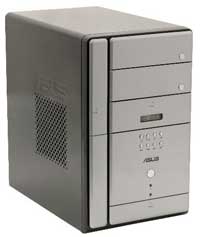 |
| Click images to enlarge. | |
Socket 478 SFF Alternative: ASUS Terminator T2-P or T2-P Deluxe
Price: $137 or $162/$220 shipped
Providing one of the best values for a SFF system, the ASUS T2 line includes a ton of features. Integrated graphics come standard via the 865G chipset, or if you want to look at the T2-R, you could get the ATI 9100IGP graphics - as we mentioned in the motherboard section, the ATI 9100IGP provides better graphics support, but worse overall CPU performance. Sound and networking are standard fare, along with two DIMM slots. The Deluxe model adds in 802.11B WLAN, a gigabit Ethernet (GbE) connection, firewire, a flash card reader, and a radio tuner, along with an enhanced front panel with controls for the radio and CD functions. Both models include a floppy drive.
The case looks good and runs reasonably quiet, but there are a few drawbacks. First, the hinged front covers look nice, but they feel very flimsy; they're not spring loaded, and they're made of cheap plastic. If you don't handle your computer with care, it would be relatively easy to break off some of the plastic "doors". Another problem is that the Deluxe model is available in two versions, so you'll have to make sure that you get the right one. The cheaper version does not include the wireless networking, firewire, GbE, or a CD drive while the "commercial" version adds these extras. The power supply is only rated at 200W, so running a high-end graphics card like a 6800GT or X800 Pro could prove troublesome, but we can attest that the 9800 Pro/XT work without problems. Finally, the case is not a truly small SFF design - it's really about half the size of a standard mini-tower and 50% larger than most other SFF cases. Still, it's not a bad value overall, regardless of which model you choose.
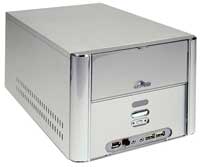 |
 |
| Click images to enlarge. | |
Socket A SFF Alternative: BioStar iDEQ 210VB or 200N
Price: $172 or $207 shipped
For socket A from BioStar, we have two options that meat our criteria. The cheaper option is the 210VB, which uses the VIA KM400A chipset and includes the UniChrome integrated graphics. It also includes firewire, USB, SATA, audio, and 10/100 Ethernet. The more expensive 200N is the preferred version, not only because it uses the superior Nforce2 chipset with MCP-T, but also because it includes two VGA ports powered by a GeForce 4MX core and we prefer the silver aluminum case to the black one. Otherwise, they are very similar in design and features. Again, high-powered graphics cards might push the capabilities of the included 200W PSU, but then a high-powered graphics card would be overkill for an aging Athlon XP/Sempron system. Note that this motherboard supports a maximum bus speed of 333 MHz, so the 400 MHz bus Athlon XP 3000+ and 3200+ are not an option. Given their price, however, we don't think that many people would really consider them anyway.
Socket A SFF Alternative: EPoX Mini Me EP-EX5300NR
Price: $221 shipped
Socket 478 SFF Alternative: EPoX Mini Me EX5-300S
Price: $192shipped
These two cases look very similar internally and externally, but there are a few major differences. First is the CPU socket type, of course, which dictates many of the features. The socket A model also includes a remote control and 250W PSU (instead of a 200W), but it lacks support for SATA - that's important, considering our hard drive recommendations; get a Seagate or Samsung IDE drive instead if you choose the EX5300NR system. Beyond that, features are similar to what other cases offer: firewire, audio, LAN, USB and integrated graphics - the Nforce2 IGP's GF4MX for the AMD system and the 865G's Extreme Graphics 2 on the Intel platform. Both models do not support a floppy drive, although they also come with a flash card reader in the 3.5" bay. On the bottom of the front face is a moderately large display that can be configured to show system parameters; some may like it, and others may find it distracting, as it does tend to be a little bright at face level. Similar to the BioStar cases, only 266 and 333 FSB Athlon XP/Sempron are supported on the socket A model.
Finally, a word of caution: this is a case that may be too small for its own good, as fitting in a moderate size graphics card can bump into the hard drive, causing it to warp the graphics card slightly. We're not particularly thrilled by that prospect, so we would recommend that users who intend to add a decent graphics card to their system look elsewhere. Given the price, features, and diminutive size - remember that in the SFF world, smaller is generally more expensive - it's a decent option, provided that you keep the above comments in mind.
Socket 754 SFF Alternative: Shuttle XPC SK83G
Price: $207 shipped
As our sole representative of the socket 754 platform, we have the Shuttle SK83G. Shuttle also has a few other moderately-priced offerings that some might find interesting, but they tend to cost more than some of the competitors and offer less in the way of features. For example, the SB65G2 is a decent model that lacks integrated graphics, so a separate graphics card would be required. The SN45GV2 is similar in that it uses the Nforce2 Ultra chipset and requires discrete graphics. On the low end, we have the SB51G that includes integrated graphics, but uses the 865GE chipset instead of the slightly more powerful 865G. None of them are terrible choices, but they also don't have much to set them apart in the budget sector.
Returning to the SK83G, let's look at the features. It is reasonably priced and includes a 240W PSU, integrated UniChrome Pro graphics courtesy of the VIA K8M800 chipset, plus all of the other usual suspects: firewire, USB, SATA (plus RAID), audio and networking. An S-Video connection is supported in addition to the VGA connector, which makes this an interesting option for a Home Theater PC if you're interested. Something that other cases neglect is the inclusion of a cover for the 3.5" external bay, should you decide to forego the floppy drive or use that bay for a second hard drive.
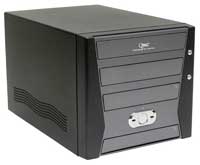 |
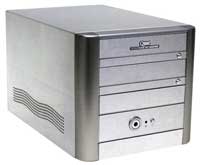 |
| Click images to enlarge. | |
Socket A SFF Alternative: Soltek QBiC EQ3704GD or EQ3705A
Price: $177 or $192 shipped
Wrapping things up with our SFF suggestions, we come to Soltek and their QBiC line. There are several systems that fall into the $200 and below range, but we aren't going to bother with the VIA C3 options, so we're left with the versions based on the KM400A VIA chipset and the NVIDIA Nforce2 IGP. The 3704 is available in several different color schemes, of which we selected the gray/black model. It's a little cheaper than the 3705, but you also lose some performance on the CPU and graphics fronts. In other areas, however, you gain some features: the 3704 includes GbE as well as SATA/RAID, while the 3705 lacks these features. As with the EPoX system, if you are considering the 3705, make sure that you get an IDE drive instead of an SATA drive. It's a personal preference, but we also prefer the look of the aluminum 3705 case. Otherwise, features are the same as the other options: firewire, USB, audio, and network. The Soltek models also include a larger 250W PSU, and you can even fit two optical drives in each case. Using the bottom 5.25" drive bay for a second optical drive will prevent the use most PCI cards, however.
System Summaries
We end up with a total of four system configurations, not counting the SFF case options. As we mentioned earlier, we have stuck with integrated graphics on the "true" budget platforms, while we opt for more powerful discrete graphics as a performance upgrade. Think of the "Performance" listings as something in between the budget and mid-range platforms. They're still cheaper than what we typically suggest for the mid-range, but they're quite a bit more than the $500 budget target.Of course, we overshot the $500 budget with even the "cheap" platforms by $100 or so. If you really want to cut costs further, dropping the RAM to 256 MB and going with a CD-RW or DVD-ROM would get your pretty close to the $500 mark. In contrast to earlier Budget Guides, note that we included a floppy, keyboard, and mouse into the final total. If you can make do with your current monitor - assuming you have one - that would also lower the price quite a bit. We could make other excuses, but the simple answer is that prices have been pretty much stagnant in the budget sector, we've increased some areas of performance, and we would rather spend a little more than get less out of the system.
AMD Budget Summary
| Budget AMD Socket A System | ||
| Hardware | Recommended Component | Price |
| Processor | AMD Sempron 2400+ 256K 1.67 GHz 333 MHz bus | $63 |
| Motherboard | MSI K7N2GM2-LSR Nforce2 IGP | $72 |
| Memory | 2x256 MB Corsair Value Select CL3 | $68 |
| Video Card | NVIDIA GeForce4 MX440 (Nforce2 IGP) | $0 |
| Hard Drive | Seagate 80 GB 7200 RPM 8MB SATA | $69 |
| Optical Drive | NEC DVD+/-RW Drive Model 3500A/3520A | $65 |
| Floppy Drive | NEC/TEAC/Sony/Samsung/etc. | $8 |
| Case and Power Supply | RaidMax Elite ATX-208BP with 380W PSU | $46 |
| Display | Samsung 793DF/793MB 17" CRT | $145 |
| Speakers | Creative Labs SBS270 2.0 | $27 |
| Keyboard and Mouse | Logitech Internet Pro Keyboard and Mouse | $25 |
| Bottom Line | $588 | |
AMD Performance Summary
| Performance AMD Socket 754 System | ||
| Hardware | Recommended Component | Price |
| Processor | AMD Athlon 64 2800+ 1.8 GHz | $127 |
| Motherboard | Chaintech VNF-250 Nforce3 250 | $73 |
| Memory | 1x512MB Mushkin Basic 2.5-4-4 | $70 |
| Video Card | Sapphire Radeon 9600 Pro 128MB DDR 128-bit 400/600 MHz | $105 |
| Hard Drive | Samsung 160 GB 7200 RPM 8MB SATA | $92 |
| Optical Drive | NEC DVD+/-RW Drive Model 3500A/3520A | $65 |
| Floppy Drive | NEC/TEAC/Sony/Samsung/etc. | $8 |
| Case and Power Supply | Antec SLK1650B with 350W PSU | $76 |
| Display | Samsung 997DF 19" CRT | $215 |
| Speakers | Logitech X-530 5.1 Speakers | $61 |
| Keyboard and Mouse | Microsoft Basic Keyboard and Optical Mouse | $30 |
| Bottom Line | $922 | |
Intel Budget Summary
| Budget Intel Socket 478 System | ||
| Hardware | Recommended Component | Price |
| Processor | Celeron D 320 2.4 GHz 256K L2 Cache (478) | $72 |
| Motherboard | Intel D865GBF i865G | $86 |
| Memory | 2x256 MB Corsair Value Select CL3 | $68 |
| Video Card | Intel Extreme Graphics 2 (i865G) | $0 |
| Hard Drive | Seagate 80 GB 7200 RPM 8MB SATA | $69 |
| Optical Drive | NEC DVD+/-RW Drive Model 3500A/3520A | $65 |
| Floppy Drive | NEC/TEAC/Sony/Samsung/etc. | $8 |
| Case and Power Supply | RaidMax Elite ATX-208BP with 380W PSU | $46 |
| Display | Samsung 793DF/793MB 17" CRT | $145 |
| Speakers | Creative Labs SBS270 2.0 | $27 |
| Keyboard and Mouse | Logitech Internet Pro Keyboard and Mouse | $25 |
| Bottom Line | $611 | |
Intel Performance Summary
| Performance Intel Socket 775 System | ||
| Hardware | Recommended Component | Price |
| Processor | Intel Pentium 4 520 2.8 GHz 1024K L2 Cache | $158 |
| Motherboard | Chaintech V915P i915P | $96 |
| Memory | 2x256 MB Corsair Value Select CL3 | $68 |
| Video Card | Albatron GeForce 6600 128 MB DDR 128-bit 300/550 | $122 |
| Hard Drive | Samsung 160 GB 7200 RPM 8MB SATA | $92 |
| Optical Drive | NEC DVD+/-RW Drive Model 3500A/3520A | $65 |
| Floppy Drive | NEC/TEAC/Sony/Samsung/etc. | $8 |
| Case and Power Supply | Antec SLK1650B with 350W PSU | $76 |
| Display | Samsung 997DF 19" CRT | $215 |
| Speakers | Logitech X-530 5.1 Speakers | $61 |
| Keyboard and Mouse | Microsoft Basic Keyboard and Optical Mouse | $30 |
| Bottom Line | $991 | |
You'll still need an Operating System as well, unless you plan on running some free OS such as one of the many flavors of Linux. XP Home runs about $90 for an OEM version, which you can pick up from most online sites if you buy qualifying hardware, while XP Professional will run about $135. The Professional version includes a few networking and security extras that we like to have, but most people will be fine with Home. Running an older version of Windows is also possible, but we don't recommend it due to outdated drivers and other usability enhancements that are only available with XP. There's no point in buying new hardware and then using an old OS, especially considering that XP itself is now over three years old.


